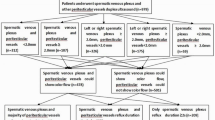Abstract
Aim
The aim of this work is to propose a new hemodynamic classification of male varicoceles that can improve the accuracy of staging and the quality of the examination report. We retrospectively analyzed data on outpatients referred to our vascular ultrasonography service by general practitioners or urologists for work-up of “varicoceles.” Quantification and characterization of venous reflux is essential for selecting patients who require treatment and for evaluating the latter’s effectiveness, as demonstrated by our experience in a subgroup of 58 patients referred for imaging after surgery on endovascular procedures.
Materials and methods
We performed scrotal Doppler sonography on 278 males seen during the period 2009–2011 for doubts raised during clinical assessment of varicoceles or for postoperative evaluation of residual reflux.
Results
The diagnosis of varicocele was confirmed on 193 subjects; in 32 patients who had undergone percutaneous or surgical treatment the examination demonstrated the presence of residual reflux, while in 85 cases the presence of pain or a scrotal mass was not associated with venous reflux.
Conclusions
Standardized instrumental criteria have been developed for the diagnosis of varicoceles but not for their staging. The classification system we propose provides a simple, hemodynamically accurate method for qualitatively evaluating venous reflux, and it can be a useful tool for verifying the success of surgical and endovascular procedures for correcting varicoceles.
Sommario
Scopo
Lo scopo del lavoro è quello di proporre una nuova classificazione emodinamica che ci sembra idonea ad una corretta stadiazione del varicocele maschile ed al miglioramento della qualità del referto dell’esame. Abbiamo effettuato l’analisi retrospettiva di una casistica ambulatoriale di pazienti afferenti al nostro servizio di ultrasonologia vascolare inviati dal medico di Medicina generale o dallo specialista Urologo col quesito “varicocele”. La quantificazione dell’entità e della qualità del reflusso è un essenziale strumento per la selezione dei Pazienti sia da avviare al trattamento, sia per la valutazione dell’efficacia del trattamento stesso, come abbiamo evidenziato in un sottogruppo di 58 pazienti giunti per controllo dopo trattamento chirurgico o endovascolare.
Materiali e Metodi
Abbiamo eseguito un eco-color-doppler scrotale a 278 maschi che si sono presentati nel periodo 2009–2011 per un dubbio diagnostico a seguito di valutazione clinica o per uno studio postchirurgico dell’eventuale reflusso residuo.
Risultati
La diagnosi di varicocele è stata confermata in 193 soggetti; in 32 Pazienti precedentemente sottoposti a trattamento chirurgico o percutaneo è stata dimostrata la presenza di reflusso residuo, mentre in 85 casi la presenza di dolore o massa scrotale non erano associate a reflusso venoso.
Conclusioni
Attualmente esistono criteri strumentali standardizzati per la diagnosi, ma non per la stadiazione del varicocele. La nostra classificazione si propone come una metodica semplice ed emodinamicamente corretta per la valutazione della qualità del reflusso venoso e può essere un utile strumento di valutazione del successo o meno delle procedure correttive chirurgiche o endovascolari.







Similar content being viewed by others
References
Jarow JP (2001) Effects of varicocele on male fertility. Hum Reprod Update 7:59–64
Levinger U, Gornish M, Gat Y, Bachar GN (2007) Is varicocele prevalence increasing with age? Andrologia 39:77–80
Nistal M, González-Peramato P, Serrano A, Regadera J (2004) Physiopathology of the infertile testicle. Etiopathogenesis of varicocele. Arch Esp Urol 57(9):883–904
Saypol DC (1981) Varicocele. J Androl 2:61–71
Coolsaet BL (1980) The varicocele syndrome: venography determining the optimal level for surgical management. J Urol 124:833–839
Kumanov P, Robeva RN, Tomova A (2008) Adolescent varicocele: who is at risk? Pediatrics 121:e53–e57
Sarteschi LM, Menchini Fabris GM (2003) Ecografia andrologica. Athena audiovisuals, Modena
Società Italiana di Diagnostica Vascolare SIDV-GIUV (2012) Procedure operative per indagini diagnostiche vascolari. J Int Angiol 31:39
Bechara CF, Weakley SM, Kougias P, Athamneh H, Duffy P, Khera M et al (2009) Percutaneous treatment of varicocele with microcoil embolization: comparison of treatment outcome with laparoscopic varicocelectomy. Vascular 17(Suppl 3):S129–S136
Ayechu-Díaz A, Oscoz-Lizarbe M, Pérez-Martínez A, Pisón-Chacón J, Esparza J, Bento L et al (2009) Treatment of adolescent varicocele: is percutaneous embolization better? Cir Pediatr 22(3):134–138
Dubin L, Amelar RD (1970) Varicocele size and results of varicocelectomy in selected subfertile men with varicocele. Fertil Steril 21:606–609
Liguori G, Trombetta C, Garaffa G, Bucci S, Gattuccio I, Salamè L et al (2004) Color Doppler ultrasound investigation of varicocele. World J Urol 22:378–381
Turchi P, Sarteschi ML, Benelli R, Menchini Fabris FM et al (2000) Unexplained male infertility and testicular microlithiasis. Arch Ital Urol Androl 72(4):245–248
Conflict of interest
None.
Author information
Authors and Affiliations
Corresponding author
Rights and permissions
About this article
Cite this article
Iosa, G., Lazzarini, D. Hemodynamic classification of varicoceles in men: our experience. J Ultrasound 16, 57–63 (2013). https://doi.org/10.1007/s40477-013-0016-y
Received:
Accepted:
Published:
Issue Date:
DOI: https://doi.org/10.1007/s40477-013-0016-y




